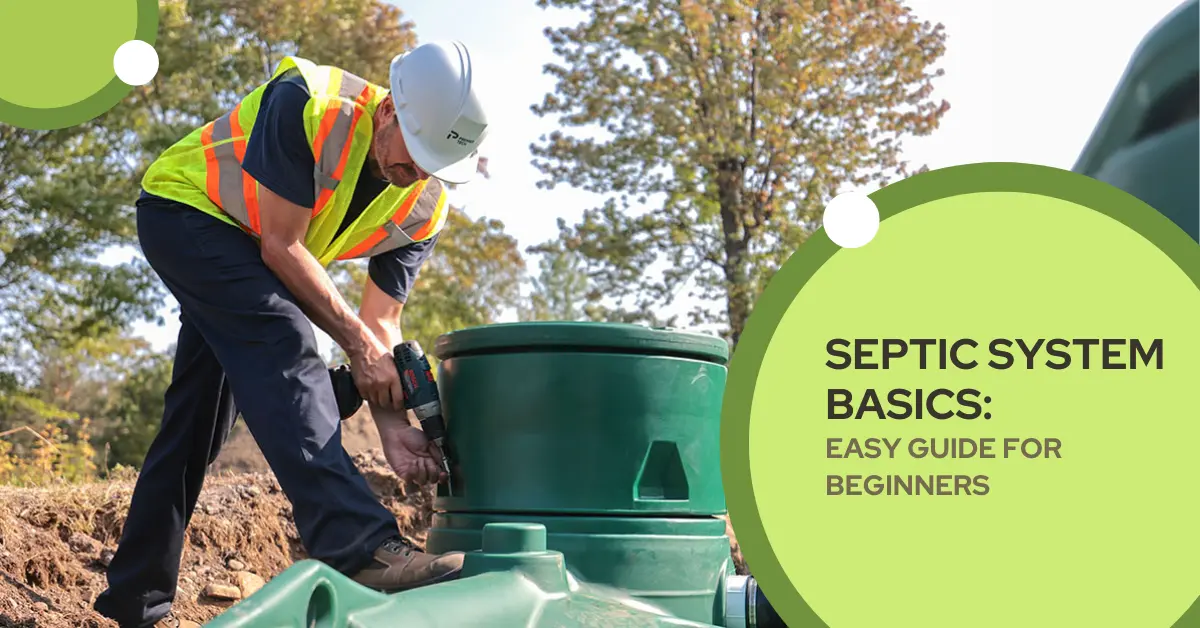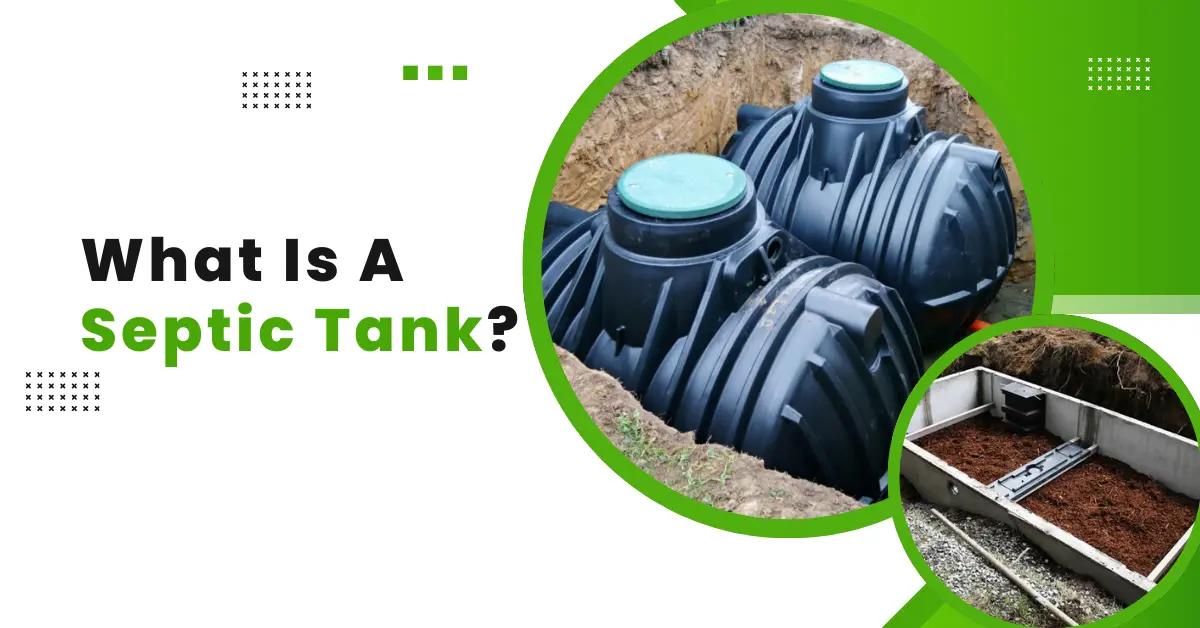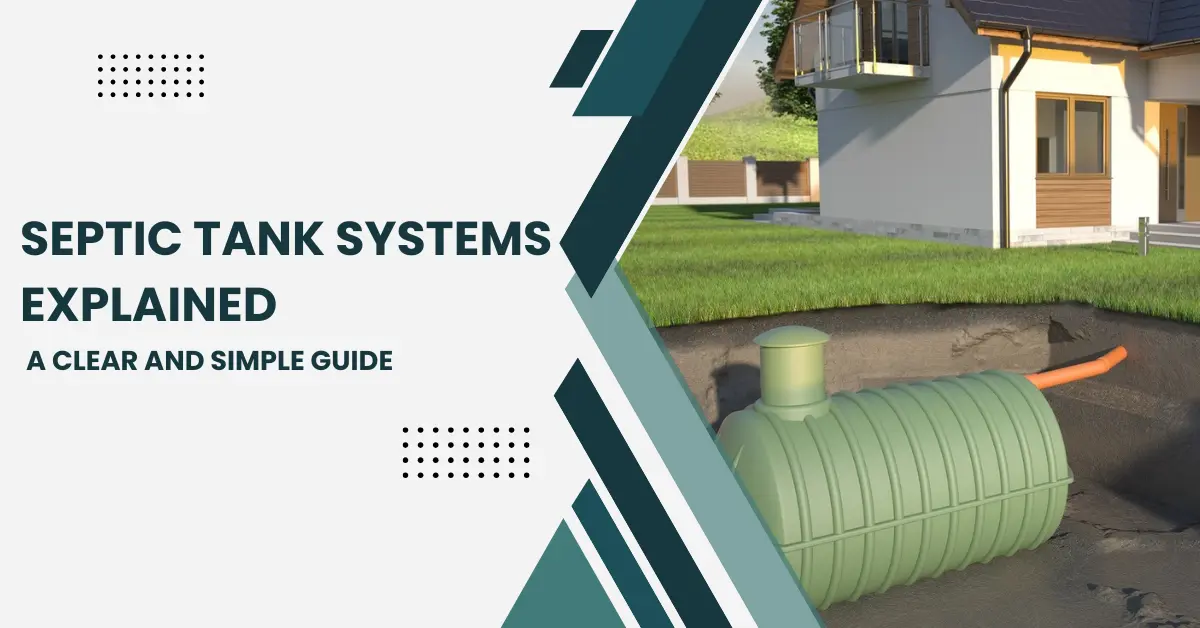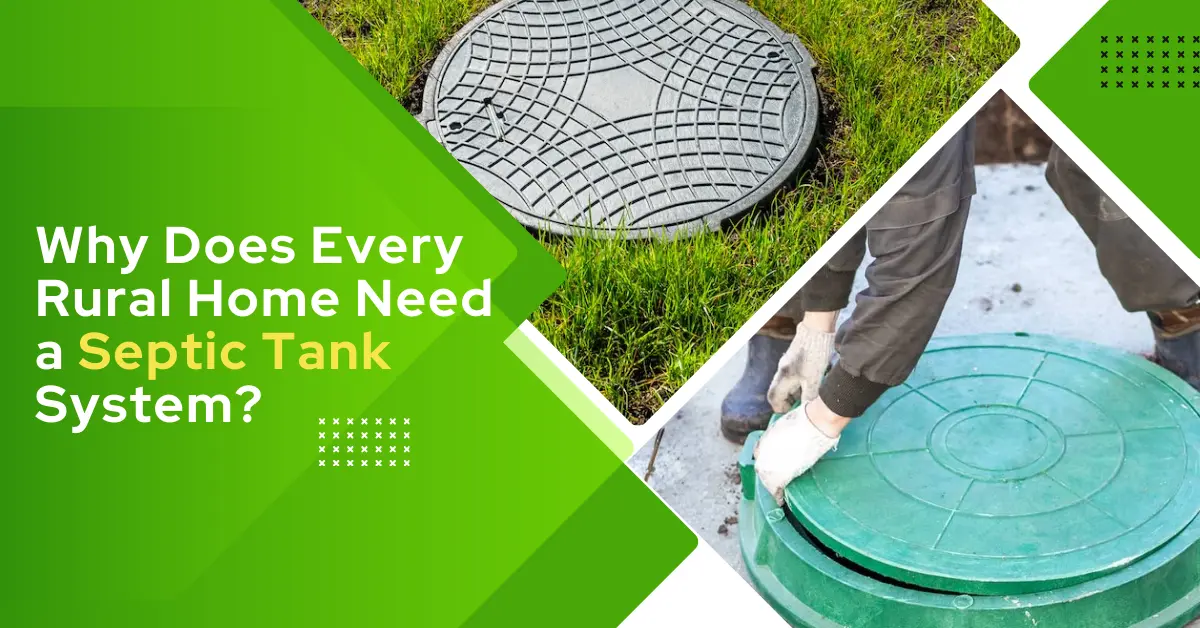A septic system is a crucial component of many homes, especially those in rural and non-urban areas where access to municipal sewer lines is unavailable.
Simply put, a septic system is an on-site underground buried wastewater treatment system that safely processes and disposes of household wastes and protects your home.
Understanding how a septic system works, its main components like the septic tank and drainfield, and the different types available, like the conventional gravity-fed systems to advanced aerobic units, is essential for homeowners.
In this comprehensive guide, we’ll cover everything you need to know about septic systems, including how they function, the importance of proper installation and maintenance, and the differences between septic and sewer systems.
We’ll also break down costs, share expert tips, and answer frequently asked questions to ensure you have all the knowledge you need in one place.
Therefore, let’s get started!
What is a Septic System?
A septic system is an underground wastewater treatment solution commonly used in homes and properties that are not connected to a municipal sewer system.
It is designed to collect, treat, and safely dispose of household wastewater underground.
A septic system includes a septic tank, inlet or outlet pipes, and a drainfield (or leach field), which work together to treat sewage through natural processes.
Purpose of a Septic System
The primary purpose of a septic system and why the septic tank is so important is to manage and treat wastewater from our everyday activities , such as bathing, cooking, and flushing toilets.
Instead of sending wastewater to a centralized sewage treatment plant, septic systems process this water locally.
They separate solids, digest organic matter, and allow treated liquids to soak through the soil, where natural filtration removes harmful bacteria and pollutants.
This helps prevent environmental contamination, protects groundwater quality, and ensures public health safety.
How a Septic System Differs from Municipal Sewer Systems?
Unlike municipal sewer systems, which transport sewage through a network of pipes to a centralized treatment facility, septic systems operate independently on-site. Here are the key differences:
Location of Treatment
Septic system: Treats wastewater on the property itself.
Municipal sewer: Transports wastewater to a distant treatment plant.
Cost and Suitability
Septic system: More cost-effective and practical in rural, suburban, or areas where sewer lines don’t reach.
Municipal sewer: Typically found in urban and developed regions with dense populations.
Infrastructure and Maintenance
Septic system: Requires a private underground tank and drainfield; maintenance is the homeowner’s responsibility.
Municipal sewer: Uses extensive underground pipe networks; local government or utility companies manage maintenance.
Environmental Impact
Septic system: Relies heavily on proper design, regular maintenance, and soil conditions to prevent contamination. Poorly maintained systems can pose risks to groundwater.
Municipal sewer: Centralized treatment can handle large volumes.
Why You Might Need a Septic System?
Understanding the use cases and suitability of septic systems helps homeowners, builders, and buyers determine if this system is right for their needs.
Common Use Cases for Septic Systems
1. Rural and Remote Areas
Many rural homes and properties are located far from public sewer infrastructure.
It makes the septic systems the most practical and cost-effective option for managing wastewater.
In these areas, extending sewer lines can be prohibitively expensive or technically unfeasible.
2. Unconnected zones and Mobile Homes
Properties that operate independently from city utilities, such as cabins, mobile homes, or tiny houses, often rely on septic systems for onsite wastewater treatment.
3. Properties with Environmental or Terrain Challenges
In areas with unique soil conditions, wetlands, or topography that preclude sewer construction, septic systems offer flexible solutions.
4. New Developments Without Sewer Access
Some newly developed residential or commercial plots in suburban or semi-rural locations may not yet have access to municipal sewer lines, requiring septic system installation.
Suitability Factors for Septic Systems
Before choosing a septic system, consider these important factors,
1. Soil Type and Drainage
Suitable soil is critical for a septic system’s drainfield to effectively filter and absorb wastewater.
Sandy or loamy soils are ideal, while heavy clay or rocky soils may require specialized system designs or alternative treatment methods.
2. Water Table and Flood Risk
High groundwater levels or flood-prone areas can interfere with septic system operation and increase contamination risks.
3. Space Availability
Septic systems need adequate space for the septic tank and drainfield.
Smaller lots may have limited capacity for conventional systems and might need advanced or compact septic solutions.
4. Local Regulations and Permits
Many municipalities and counties have specific regulations governing septic system installation, operation, and maintenance.
It’s essential to check local codes to ensure compliance.
Core Components of a Septic System
A septic system relies on several key components that work together to treat and safely dispose of household wastewater.
These parts help homeowners maintain their systems properly and recognize potential issues early. Those are,
1. Primary Drain Line (Wastewater Conveyance Pipe)
This is the pipe that connects your home’s plumbing system, such as toilets, sinks, showers, and washing machines, to the septic tank.
It carries all the wastewater away from your home and into the septic system for treatment. Proper design and slope of this line are crucial for smooth flow and to prevent backups.
2. Septic Tank
The septic tank is an underground, watertight container that temporarily holds wastewater from your home.
Its primary function is to separate solids from liquids. It allows heavy solids to settle at the bottom (forming sludge), while lighter materials like oils and fats float to the top (forming scum).
The partially treated liquid in the middle, called effluent. Then it flows out into the drainfield for more treatment.
Materials Used
Septic tanks are commonly made from durable materials such as,
- Concrete – sturdy and long-lasting, but heavy and prone to cracking if not maintained properly
- Fiberglass – lightweight, corrosion-resistant, and easier to install
- Plastic (polyethylene) – affordable and resistant to rust or corrosion, but can be damaged by heavy loads if not buried correctly
Scum, Sludge, and Effluent: Layer Breakdown
Inside the tank, wastewater naturally separates into three layers,
- Scum: Floating layer of oils, grease, and lighter solids on top
- Sludge: Heavy solids that settle at the bottom
- Effluent: Clearer liquid in the middle that exits the tank to the drainfield
Regular pumping is necessary to remove sludge and scum to prevent system failure.
3. Distribution Box
After the septic tank processes the wastewater, the distribution box evenly distributes the liquid effluent to the drainfield pipes.
This ensures the wastewater flows uniformly across the drainfield. It prevents overloading or premature failure of one section of the soil absorption area.
4. Drainfield (Leach Field)
The drainfield is a network of pierced pipes buried underground, filled with gravel or sand.
Its job is to disperse the effluent evenly into the soil, where natural filtration and microbial action further purify the wastewater.
Soil acts as a natural filter, trapping harmful bacteria, viruses, and nutrients. As effluent percolates through the soil layers, biological and chemical processes break down contaminants.
How Does a Septic System Work?
Curious about the inner workings of the tank itself? Here’s a detailed look at how a septic tank works within the overall system.
Step 1: Wastewater Leaves Home
All wastewater from your home’s toilets, sinks, showers, and appliances flows into a single primary drain line.
This pipe carries the wastewater underground and directs it toward the septic tank.
Step 2: Wastewater Enters the Septic Tank
Once inside the septic tank, wastewater slows down. Then, it allows solids and liquids to separate naturally.
Heavy solids settle to the bottom and forms a layer called sludge, while lighter materials like oils and grease rise to the top, forming scum.
The clear liquid in the middle, called effluent, remains between these layers.
Step 3: Bacteria Break Down Organic Matter
Inside the septic tank, anaerobic bacteria (bacteria that lives without oxygen) begin to digest and decompose the organic waste in the sludge and scum.
This biological process reduces the volume of solids and turns them into simpler substances, gases, and liquids. It helps prevent the tank from filling up too quickly.
Step 4: Effluent Moves to the Distribution Box
The partially treated liquid effluent exits the septic tank through an outlet pipe and flows into the distribution box.
This box evenly distributes the effluent into the drainfield (also called the leach field).
Step 5: Effluent is Distributed into the Drainfield
The effluent goes through a network of pierced pipes underground, filled with gravel or sand. It slowly seeps out of the pipes and into the surrounding soil.
Step 6: Natural Filtration
The soil acts as a natural filter. It removes the harmful bacteria, viruses, and nutrients from the effluent.
Aerobic bacteria in the soil further break down contaminants as the wastewater seeps in deeper.
This natural biological and chemical treatment process ensures the water is purified before it reaches groundwater or surface water sources.
Types of Septic Systems
You need to understand the types to choose the most effective septic system for your property’s specific soil conditions, climate, budget, and wastewater treatment needs.
1. Conventional (Gravity-Fed) Septic System
This is the most common type of septic system. Wastewater flows from the house into a septic tank and then, by gravity, into a drainfield where it is naturally filtered by the soil.
Pros
- Simple design and low installation cost
- Minimal mechanical parts, fewer maintenance needs
Cons
- Requires adequate, well-draining soil and sufficient space
- Not suitable for areas with high groundwater or poor drainage
Best For
Properties with suitable soil that allow natural gravity flow.
2. Chamber System
Instead of gravel-filled trenches, this system uses plastic chambers to create a drainfield. It allows wastewater to disperse into the soil.
Pros
- Easier and faster to install than traditional gravel drainfields
- Provides more storage capacity for wastewater
Cons
- Slightly higher initial cost than conventional systems
- Requires careful design to avoid clogging
Best For
Sites with space constraints or where rapid installation is necessary.
3. Drip Distribution System
This system uses a network of small-diameter pipes to drip wastewater slowly into the soil, often near the surface.
Pros
- Can be used on sloped or uneven terrain
- Efficient use of available soil for treatment
Cons
- Requires frequent maintenance and monitoring
- Pumps and filters increase complexity and cost
Best For
Properties with limited drainfield space or challenging topography.
4. Mound System
This one is used where the natural soil is unsuitable for wastewater absorption. A mound system builds an elevated sand and gravel mound to treat and distribute effluent.
Pros
- Effective in areas with high groundwater or shallow bedrock
- Protects groundwater from contamination
Cons
- Higher installation and maintenance costs
- Requires more land area
Best For
Locations with poor soil drainage or high water tables.
5. Aerobic Treatment Units (ATUs)
These systems introduce oxygen into the septic tank to promote aerobic bacteria growth. It improves wastewater treatment before discharge.
Pros
- Higher quality effluent suitable for sensitive environments
- Smaller drainfields are needed compared to conventional systems
Cons
- Requires electricity and regular monitoring
- Higher installation and maintenance costs
Best For
Properties near lakes, rivers, or where local regulations demand advanced treatment.
6. Recirculating Sand Filter System
Wastewater is pumped through a sand filter repeatedly. It allows bacteria to break down contaminants before dispersal.
Pros
- Provides advanced treatment of wastewater
- Can handle higher loads and treat more pollutants
Cons
- A more complex system with pumps and controls
- Requires electricity and regular maintenance
Best For
Sites needing enhanced treatment or where strict environmental regulations apply.
7. Evapotranspiration Systems (Climate-Dependent)
Wastewater is treated and evaporated through soil and plants with evaporation and transpiration processes.
Pros
- Suitable for arid or semi-arid climates with low rainfall
- Minimal groundwater contamination risk
Cons
- Not suitable for wet climates
- Requires significant land area and careful design
Best For
Dry regions where evaporation rates are high.
How to Choose the Right Septic System?
Selecting the right septic system for your property is crucial to ensure effective wastewater treatment, protect the environment, and avoid costly repairs.
1. Evaluate Your Soil Type and Drainage
Conduct a soil percolation test (or perc test) to determine how well your soil absorbs water.
Sandy soils drain quickly and may require smaller or conventional systems. Whereas, clay soils drain slowly and might need alternative systems like mound or drip distribution.
Poor drainage or high water tables may necessitate advanced treatment options such as aerobic treatment units (ATUs) or mound systems.
2. Consider Your Property Size and Layout
Larger properties typically have more space for conventional drainfields.
Smaller or irregularly shaped lots may require compact systems like chamber or drip distribution systems.
Steep slopes or rocky terrain might limit traditional options and call for specialized systems.
3. Understand Your Household Wastewater Needs
Larger families or homes with higher water usage may need systems with greater capacity or enhanced treatment.
Consider future expansions or additions that could increase wastewater volume.
4. Assess Local Climate and Environmental Factors
In wet or flood-prone areas, systems that protect groundwater from contamination (mound systems, ATUs) are recommended.
Dry climates might benefit from evapotranspiration systems. Check for local regulations that could influence system selection or require specific designs.
5. Budget and Maintenance Requirements
Conventional systems tend to have lower initial and maintenance costs.
Advanced systems like ATUs or recirculating sand filters require higher initial investment and regular servicing, but offer superior treatment.
Factor in long-term costs and the availability of professional maintenance services in your area.
6. Consult Professionals and Local Authorities
Work with a licensed septic system designer or installer who can evaluate your site conditions and recommend the best system.
In addition, check with local health departments or environmental agencies for permits, guidelines, and approved system types in your region.
Maintenance Essentials
Proper maintenance of your septic system is essential for protecting your home, health, and environment. Here’s what every homeowner should know.
1. How Often to Pump the Septic Tank
- General Rule: Pump your tank every 3 to 5 years. Though it depends on household size, water usage, and tank capacity.
- Heavier Usage: Large families or homes with garbage disposals may require more frequent pumping (every 2–3 years).
- Light Usage: Smaller households or homes with high-efficiency fixtures may stretch closer to 5 years.
2. What NOT to Flush or Pour Down Drains
To avoid clogging or upsetting the bacterial balance inside the tank, never dispose of the following in your septic system:
- Grease, oils, or fats
- Feminine hygiene products or diapers
- Flushable wipes
- Coffee grounds or food scraps
- Paints, solvents, or harsh chemicals
- Excessive bleach or antibacterial cleaners
These items either don’t break down or kill essential bacteria. It leads to a buildup and potential failure.
3. Seasonal Care: Winter & Wet Weather Tips
During winter, it’s important to insulate exposed pipes using foam or straw to prevent them from freezing.
Avoid compacting snow over the drainfield, as packed snow loses its natural insulating ability.
Also, try to limit water use during freezing periods to reduce pressure on a septic system that may already be moving slowly due to cold temperatures.
In wet weather, heavy rainfall can flood the drainfield and disrupt the system. ‘
Make sure to redirect roof gutters and surface runoff away from the septic area.
Additionally, never drive or park over the drainfield during or after rain, as saturated soil gets compacted easily, leading to poor drainage and possible damage.
4. Signs of System Trouble
Know the red flags before a small issue becomes a big mess.
- Slow drains or gurgling sounds in pipes
- Unpleasant odors around the tank or drainfield
- Water pooling on or near the drainfield
- Backups in sinks, showers, or toilets
- Unusually green, lush grass over the drainfield
5. DIY vs. Professional Inspections
For DIY maintenance, start by checking tank lids and risers for any cracks or damage that could allow debris or rainwater inside.
Keep an eye on your water usage habits, and stay alert for warning signs like slow drains or foul odors.
If you’re considering additives, use only enzyme-based products if recommended, as not all additives are effective or necessary.
When it comes to professional inspections, it’s best to schedule one every 1 to 3 years.
These inspections help check sludge levels, detect leaks, and assess the overall health of your system.
Licensed inspectors can spot problems early and offer solutions before they turn into costly repairs.
6. Repair vs Replacement Costs
Understanding the costs involved can help you plan and act early.
| Issues | Estimated Cost |
| Minor Repairs (pipes, baffles) | $200 – $1,500 |
| Septic Tank Replacement | $3,000 – $10,000+ |
| Drainfield Restoration | $2,000 – $8,000 |
| Full System Replacement | $10,000 – $25,000+ |
Cost Breakdown
Installing and maintaining a septic system is a significant and long-term investment, but with proper planning and care, it can be a cost-effective long-term solution for homes.
Below is a breakdown of the major costs involved.
1. Installation Cost Range
The total cost to install a septic system depends on several factors. Such as system type, soil conditions, location, and labor rates.
| System Type | Estimated Installation Cost |
| Conventional (gravity-fed) | $3,500 – $15,000 |
| Chamber System | $5,000 – $12,000 |
| Drip Distribution System | $8,000 – $18,000 |
| Mound System | $10,000 – $20,000 |
| Sand Filter or Recirculating Filter | $8,000 – $11,000 |
| Aerobic Treatment Unit (ATU) | $10,000 – $50,000 |
| Evapotranspiration System | $10,000 – $15,000 |
2. Maintenance and Pumping Expenses
Routine care is essential and affordable.
- Tank Pumping (every 3–5 years): $200 – $600
- Annual Inspections: $200 – $500
- Filter Cleaning/Replacement: $200 – $500
- Enzyme Additives (optional): $10 – $30/month
- Minor Repairs (baffles, seals, etc.): $200 – $600
3. Emergency Repair Costs
Septic emergencies can get expensive fast.
- Drainfield Failure Repair: $2,000 – $15,000
- Tank Replacement: $3,000 – $10,000
- Line Blockages/Leaks: $1,000 – $10,000
- Backups or Sewage Overflow Cleanup: $2,000 – $10,000
4. Long-Term Financial Outlook
Over 30 years, here’s how septic system ownership typically breaks down.
| Expense Category | Estimated Lifetime Cost |
| Installation | $3,000 – $20,000 |
| Maintenance & Inspections | $3,000 – $6,000 |
| Repairs/Upgrades | $2,000 – $10,000 |
| Total Lifetime Cost | $10,000 – $30,000+ |
If we compare this cost with the monthly sewer bills (which can total $15,000+ over 30 years), a well-maintained septic system can be a cost-effective alternative.
Septic System vs Sewer System: Which One Should You Choose?
When it’s about managing household wastewater, there are two options. Septic systems and municipal sewer systems.
Both handle waste disposal, but they differ significantly in terms of setup, maintenance, cost, and long-term suitability.
Here’s a comprehensive comparison to help you make the right decision.
1. Lifespan & Maintenance
A septic system typically lasts between 20 to 40 years with proper maintenance.
To keep it functioning well, homeowners need to schedule regular pumping, routine inspections, and use water responsibly.
All maintenance and repair responsibilities fall entirely on the homeowner.
In contrast, a sewer system is part of a city-maintained infrastructure and can last indefinitely.
Upkeep is minimal for individual users, as the city manages most repairs and maintenance tasks. The responsibility is shared among residents through taxes and utility bills.
2. Suitability by Property Type
For rural or remote locations, a septic system is usually the best option. It’s practical, self-contained, and it doesn’t rely on municipal infrastructure.
In urban or suburban areas, a sewer system is typically preferred since it’s often pre-installed and managed by the city.
Homes on large plots of land often work well with septic systems because they can be adjusted to fit the space.
On the other hand, buildings with many families or in crowded areas are better suited for sewer systems since they can handle more wastewater and serve more people at once.
3. Cost Comparison
Septic systems have a higher upfront installation cost. It can range from$3,000 to over $20,000 depending on the system type and property location.
In contrast, connecting to a sewer system usually costs between $0 to $5,000, especially if the infrastructure is already available in the area.
For monthly fees, septic systems have the advantage of being self-managed, with no regular monthly charges.
While sewer systems usually come with municipal fees ranging from $25 to $100 per month.
Routine maintenance for septic systems, such as pumping and inspections, is needed every 3 to 5 years and typically costs $250 to $600.
Sewer systems include these services in the city’s maintenance, so they are covered through taxes and utility bills.
Therefore, here is the final takeaway,
Choose a Septic System if,
- You live in a rural area
- You want long-term cost savings
- You prefer independence and environmental sustainability
Go with a Sewer System if,
- You live in a city or a suburb
- You prefer low-maintenance waste management
- You’re okay with ongoing utility bills
FAQs
1. How long does a septic system last?
A well-maintained septic system can last 20 to 40 years, or even longer. The longevity depends on factors like quality of materials (concrete tanks often outlast plastic), soil conditions, regular pumping and maintenance, and proper usage.
2. What can and can’t go into a septic system?
To protect your septic system and avoid clogs or damage:
Safe for Septic
- Human waste
- Toilet paper (septic-safe)
- Water from showers, laundry, and sinks
Avoid Flushing or Pouring
- Grease, fats, and oils
- Baby wipes, diapers, or feminine hygiene products
- Harsh chemicals or antibacterial soaps
- Medications and paints
- Coffee grounds or food scraps
3. Can you plant over a drainfield?
Yes. Some ideal plants are shallow-rooted grasses and flowers or native, non-invasive species.
You must avoid planting trees or shrubs whose roots can damage the pipes, edible gardens, or heavy landscaping.
4. Are septic systems environmentally safe?
Yes, septic systems are eco-friendly and sustainable when properly managed. Here’s why:
- They naturally filter and treat wastewater using soil and bacteria
- They reduce the load on centralized sewage treatment plants
- They replenish groundwater and prevent runoff when functioning correctly
Bottom Line
Septic systems are essential for properties without access to municipal sewers, especially in rural areas.
Understanding how they work, their core components, and the various system types like conventional, mound, and aerobic units helps homeowners and buyers make smart, long-term decisions.
Proper design, responsible use, and regular maintenance (like pumping every 3 – 5 years and avoiding harmful waste) are crucial to preventing failures and protecting both your property and the environment.
Flush smart, live clean!





